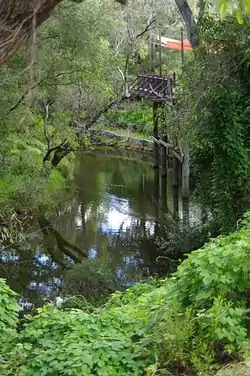Harvey River
The Harvey River is a river in Western Australia and is the southernmost of the three major waterways which drain into the Peel-Harvey Estuary, with its delta in the southern extreme of the Harvey Estuary. It is about 90 km in length, rising near Mount Keats. Due to flooding of grazing land the river was diverted to discharge directly into the ocean in 1934.
| Harvey River | |
|---|---|
 Harvey River as passes below Stirling Cottage in Harvey | |
| Location | |
| Country | Australia |
| Physical characteristics | |
| Source | |
| • location | Mount Keats |
| Mouth | |
• location | Peel-Harvey Estuary |
| Length | 90 kilometres (56 mi)[1] |
| Basin size | 2,000 square kilometres (772 sq mi)[2] |
| Discharge | |
| • average | 4,426 ML/a (0.1403 m3/s; 4.953 cu ft/s) |
The river's first recorded encounter was by Dr Alexander Collie and Lieutenant William Preston in an expedition in November 1829. It is presumed to have been named by Governor James Stirling after Rear Admiral Sir John Harvey, who in 1818 was Commander in Chief of the West Indies Station while Stirling had served in that region.
References
- Bradby, K (1997). Peel-Harvey. Greening the Catchment Taskforce. ISBN 0-7309-8041-3.
- Western Australian Land Information Authority. "History of river names – H". Retrieved 24 November 2008.
- "Bureau of Rural Science - Harvey River" (PDF). 2008. Archived from the original (PDF) on 29 October 2009. Retrieved 25 November 2008.
This article is issued from Wikipedia. The text is licensed under Creative Commons - Attribution - Sharealike. Additional terms may apply for the media files.
